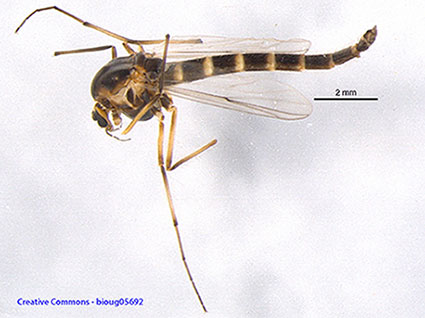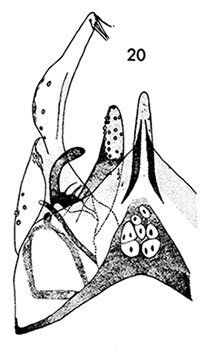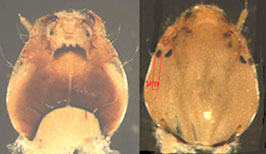Species s. C. staegeri sensu Townes 1945Synonym: C. fasciventris Malloch 1915 Note: Lindegaard (2015) notes that the larval type of C. staegeri from Greenland is probably different from that described here, as no plumosus-type larvae have been recorded from Greenland. This raises the likelihood that the current species is not C. staegeri, in which case it would become C. fasciventris Malloch 1915.
Lundbeck's original description provides little information that would enable identification of his species, other than that it is like C. hyperboreus but the beard of the foretarsus is shorter. Townes examined a male and a female of the type series and noted that both were very dark, and the superior volsella of the male was shorter than in North American specimens. This species is a member of the staegeri group erected by Wülker et al. (1971).
In BOLD Bin no. BOLD3004.
i.e. the same as C. frommeri and C. 'tigris' Adult redescribed by Townes 1945) and also by Sublette and Sublette (1971) who fortunately based their redescription on the Lectotype and Allolectotype of C. fasciventris, providing a better confirmation that this name relates to the present species.  Male: Wing length 5.58 (3.86-6.30) mm, width about 0.55mm; AR 4.70 (3.64-5.83); LR 1.40 (1.30-1.54). Body moderately slender, fore tarsus with a short beard on its outer side, appressed and all in one plane. Ground color light pruinose brown with greenish tinge, with dark brown markings. Male: Wing length 5.58 (3.86-6.30) mm, width about 0.55mm; AR 4.70 (3.64-5.83); LR 1.40 (1.30-1.54). Body moderately slender, fore tarsus with a short beard on its outer side, appressed and all in one plane. Ground color light pruinose brown with greenish tinge, with dark brown markings.
Head: frontal tubercles large 53 (30-75) µm long, clypeus rather large, 48 (26-74) clypeal setae. Palpal proportions (segs. 2-5) 4 ; 18 : 18 : 14 (C. fasciventris lectotype) - the segment 5 measurement appears low, but not noted as shrivelled, as in female. Measurement of another adult suggests it should be about 36 µm, i.e. P5/P4 and P5/P3 both about 2.0.
Thoracic setae: acrostichals - not stated; dorsocentrals 37.9 (31-48), in three rows anteriorly; prealar 9.1 (5-12); scutellar 40.3 (32-56) in a strewn pattern.
Wings: VR 0.99 (0.95-1.04) (Sublette & Sublette use: 1.01 (0.96-1.05); about 17 setae on squamal fringe.
Legs pale brown with apices of segments darker brown. BR 3.52 (2.5-4.7), mid LR 0.59 (0.55-0.70), hind LR 0.71 (0.67-0.76). 19 sensilla chaetica on pII and 13 sensilla chaetica on pIII
Abdominal tergites I-VI with a submedian transverse dark band occupying 0.3 to 0.7 of the segment, tergite VII and anal segment completely dark. About 9-11 setae in broken patches (1 or 2 per patch) in center of tergite IX.
Male hypopygium of the lectotype of C. fasciventris Malloch
From Sublette & Sublette (1971)Hypopygium: There is some difference between the figures of the hypopygium in Townes (1945) and Sublette & Sublette (1971), notably in the length and thickness of the anal point which may be attributed to mounting differences. Superior volsella long and curved , ending bluntly, closest to E(i)-type of Strenzke (1959). Inferior volsella reaching to about midpoint of the gonostyle which is moderately swollen and narrows gently over the posterior half.Female (measurements from lecto-allotype of C. fasciventris):
Coloration generally as in male, but with posterior pollenose bands on abdominal segments; genital lamellae reddish brown, rather small.
Wing length 4.88 mm. Antennal proportions 22 : 15 : 15 : 15 : 30, AR - 0.45; A5/A1 - 1.36. Frontal tubercles 82 µm. Palpal proportions (segs. 2-5) 7 : 26 : 34 : 30 (last somewhat shrivelled).
Mesoscutum with a slight tubercle. About 10 prealar setae.
Leg ratios: ant 1.51, mid 0.52, hind 0.65. 
Pupal abdomen of C. staegeri (Sublette & Sublette, 1971)Pupal exuviae: Cephalothorax blackish-brown, abdomen pale yellowish brown with darker markings. Length 9.13-13.0 mm (Female: about 9.5-13.0 mm, Male: about 9.3-13.0 mm).
Frontal tubercles short and conical, subterminal seta about 70 µm long; no secondary tubercle or frontal warts. Base of respiratory organ about 250 x 90 micron. Recurved spines at apex of tergite of segment II about 62-100 in males and 72-93 in females; caudolateral spur of segment VIII with 9.1 (7-13) spines (female), 8.1 (6-11) spines (male), closely appressed. Swim fin with about 118-125 taeniae. Fourth instar larva a large plumosus-type larva, length 20 mm (Female 13.5-28.0 mm; Male 15.6-24.2 mm), anterior pair of ventral tubules usually shorter (Female: ant. 3.12 mm (1.60-4.44), post. 3.37 mm (1.60-4.52); Male: ant. 2.51 mm (1.60-3.52), post. 2.78 mm (1.48-3.68)). Lateral tubules about 340 (230-580) µm. Anal tubules relatively long, abt, 843 (785-960) µm, at least 3x longer than wide, ventral pair may be shorter and narrower.
Ventral head length about 418 micron (355-475); width of head capsule greater than 0.85mm (Hilsenhoff & Narf 1968). Gular region dark to very dark on posterior 1/2-2/3 with center of margin slightly lower and widest just above the posterior border, frontoclypeus pale or slightly darkened. 
Gular and frontoclypeus of C. staegeri
Photos courtesy of I. Proulx.Oesophageal apperture relatively wide, 97.4 (83-127) µm long and 3.0 (2.42-3.78) times longer than wide. Mentum (Fig. c) with sharp teeth, but which become rounded with wear; c1 tooth quite broad, c2 teeth well developed and very pointed (type III); fourth laterals slightly reduced (type I-II).
Central part of anterior margin of ventromental plates (Fig. b) crenulate, a character not seen in Greenland larvae; ; VMR about 0.22-0.36, clearer than in C. 'tigris'; about 90 (81-98) striae which are clear to about 2/3 to margin, but extend almost to the margin.
Premandible (Fig. a) with relatively broad teeth, inner tooth 2.5-4.0 times the width of the outer tooth which narrows markedly along its length, teeth about equal in length or outer slightly longer. Pecten epipharyngis (Fig. a) with about 15.4 (12-20) fine sharp teeth (type A).
Antenna (Fig. e) with relatively long basal segment compared to total length of antenna, AR 2.1-2.4, and about 3.8 (3.3-4.5) times as long as wide; RO almost half way up from base of segment; ratio of segments (micron) 167 : 35 : 9.5 : 12.5 : 8.
Distance between the antennal bases less than that between the S4 setae, which are separated by about 90% of the FC width at that point.
Third inner tooth of mandible (Fig. d) lighter than other teeth (type IIIB) and may be broken - probably the reason for note by Sublette & Sublette (1971) that there may be only 2 inner teeth; about 27.8 (16-31) furrows near the base, about 14.4 (13-16) taeniae in the Pecten mandibularis.Identification: The larva of this species can be recognized by the combination of characters: large plumosus-type; dark gula but pale frontoclypeus; greater than 80 striae on ventromentum, which has a crenullated anterior margin. This does not separate it from C. crassicaudatus or C. frommeri, but does distinguish it from the larvae of C. staegeri in Greenland which is a melanotus-type larva and lacks crenulations on the ventromentum. Cytology: 3 polytene chromosomes with a modified thummi arm combination AB, CD, GEF.
Arm G region generally unpaired with a large nucleolus; bands distal to nucleolus often not clear but may contain a BR. Arm B with a nucleolus just distal to the 4 characteristic bands. Inversion polymorphism in all arms except G. staA1: 1-2c, 10-12, 3-2d, 9-4, 13-19; i.e. as holomelas A1
staA2: 1 - 2c 10, 5e - 9, 2d - 3, 12 - 11, 5d - 4, 13 - 19
staB1: Puff with distal dark bands (groups 8 - 7) about middle of arm.
staB2: Puff with proximal dark bands (group 7 - 8) near distal end of arm.
staB3: Puff approximately as sta B2.
staB4: Puff with proximal dark bands (group 7 - 8) about 1/3 from distal end of arm.
staC1: 1 - 6c, 11 - 8, 15 - 11, 6gh, 17a - 16, 7d-a, 6f-c, 17b - 22 i.e. as aberratus, pilicornis, tenuistylus, etc.
staC2: 1 - 5, 16 - 17a, 6hg, 14d - 15, 8 - 11c, 6b - 5f, 7d-a, 6f-c, 17b - 22
staD1: 1a-c, 16 - 11, 3 - 1d, 17 - 18d, 4 - 6d, 18e - 20, 7 - 10, 21 - 24 i.e. derived
staD2: 1 - 3, 11 - 18d, 4 - 6d, 18e - 20, 7 - 10, 21 - 24
staE1: 1 - 3e, 5 - 10b, 4 - 3f, 10c - 13; i.e. as cingulatus, plumosus, etc.
staE2: 4g-h, 10b - 5, 3e - 1, 4f - 3f, 10c - 13
staF1: 1 - 6a, 11 - 17, 6c-b, 9 - 6d, 10, 18 - 23 Inv6d-11 from froF1
staF2: 1a-c 9b-f, 6b-c, 17 - 11, 6a - 1d, 9a - 6d, 10, 18 - 23
staF3: 1a-c, 9b-f, 6b-c,17-14f, 6d-9a, 1d-6a, 11 - 14e, 10 18 - 23 i.e. from staF2
staF4: 1a-c, 9b-f, 6b-c, 17 - 14f, 1d - 6a, 11 - 14e, 9a - 6d, 10, 18 - 23 i.e. from staF2
staG1: Nucleolus in two parts mid arm. Molecular data:
There are sequences for COI (GenBank accession numbers KF278254-KF278268, KF278356) and ITS-2 (GenBank accession number HQ656599). Found: Numerous localities in North America.:
British Columbia - Royal Oak & Victoria (Townes 1945)
Labrador - Hopedale (Townes 1945)
Nova Scotia - Jeremy's Bay Campground, Kejimkujik Natl. Pk., (44.4066°N, -65.2455°W) (GenBank).
Northwest Territories - Cameron Bay on Great Slave Lake (Townes 1945)
Manitoba - Southern Indian Lake (Rosenberg et al., 1984); Aweme (Townes 1945); 4 km off Grand Rapids, Lake Winnipeg (Sæther
2012).
Ontario - Copanspin Farm (45.42°N, -75.87°W), Dunrobin; Lac Deschenes (45.37°N, -75.85°W), Central Experimental Farm and
Hogs Back (45.35°N, -75.68°N),Ottawa; South March (all Carleton Co.); Lake Potier, w. Sudbury (47.534°N, -82.065°W);
Clarke Lake (45.533°N, -78.271°W), Algonquin Prov. Park, Nipissing Co.
Quebec - Lake D'Alembert (42.38°N, -79.02°W, Lake Duprat (48.33°N, -79.12°W), Lake Kinojévis (48.13°N, -78.90°W), Lake
Opasatica (48.17°N, -79.33°W), all Rowyn-Noranda; Lake St. Joseph (46.88°N, -71.63°W), Quebec City (Proulx et al. 2015).
Saskatchewan - Oungre Memorial Park.
Alabama - Auburn Univerity pond.
California - Lake Davis (abt 39.70°N, -120.50°W), Plumas Co.; Prosser Reservoir, Nevada Co.
District of Columbia - Washington (Townes 1945)
Idaho - Moscow (Townes 1945)
Illinois - Dubois (Type locality of C. fasciventris), 3.5 ml n.e. Mahomet, Champaign Co.; Burlington (Townes 1945)
Indiana - Myers Lake; Crooked Lake, Noble Co.
Iowa - Davenport & Mt. Pleasant (Townes 1945)
Kansas - Lawrence, Douglas Co. (Townes 1945)
Louisiana - Many, Sabine Pa; Mound (Townes 1945).
Massachusetts - Lake Pleasant (43.555°N, 72.509°W), Franklin Co.; Amherst & Cambridge (Townes 1945)
Michigan - Detroit (Townes 1945)
Minnesota - Anderson Lake, Clearwater Co.; Bad Axe Lake, Hubbard Co.; Eagle Creek (46.13°N, -95.08°W), Eagle Bend, Todd Co.;
St. Paul, Ramsey Co. (Townes 1945)
Missouri - Atherton, Charleston & St. Louis (all Townes 1945)
New Hampshire - Berlin (Townes 1945)
New Jersy - Riverton (Townes 1945)
New Mexico - Eagle Nest Lake (36.55°N, -105.25°W), Colfax Co.; Hondo Valley, and Rio Bonito (33.45°N, -105.67°W), 2 ml. e. Bonito
Lake, Lincoln Co. (33.45°N, -105.67°W)
New York - New York State Barge canal (43.23°N, -78.30°W), nr Knowlesville, Orleans Co.; McLean, Sea Cliff & Syricuse (last 3
Townes 1945)
North Carolina - Raleigh (Townes 1945)
North Dakota - McVille Dam, Nelson Co.
Pennsylvania - Pottstown (Townes 1945)
South Dakota - Yankton; Lake Francis Case; Gavins Point National Fish Hatchery; Ardmore (Townes 1945).
Tennessee 10-Mile Creek (35.90°N, -84.07°W), Knox Co.; Beaver Creek and Clinch River (Mile 20.8), Oak Ridge.
Washington - Port Townsend & Seattle (Townes 1945)
Wisconsin - Reeder Farm, Madison (43.08°N, -89.42°W), Dane Co.; Freibauer Lake, Bayfield Co.; East Horsehead Lake, Oneida Co.;
Grand Portage Lake, Iron Co. (All of the above would be sites for C. fasciventris)
Greenland - Egedesminde (now Aasiaat)(68.71°N, -52.87°W) (Type specimens) (Townes 1945). Often in lakes to depth of 20m but also present in shallow permanent pools. Martin and Wülker (1971) suggest these may represent seperate species. Miller (1941) noted that the life cycle took 2 years in the deep Costello Lake, Algonquin Provincial Park.Morphology and cytology have been described by Wülker et al. (1971) and the patterns of arm C and D in Kiknadze et al. 2004, 2010), the latter reference also having an updated photographic map. The mtCOI sequences do not indicate the presence of more than one species, but sequence from a nuclear gene is needed to confirm this. See also C. crassicaudatus, C. frommeri, C. 'tigris' and C. hyperboreus[ Return to Index| Go to References ] |



